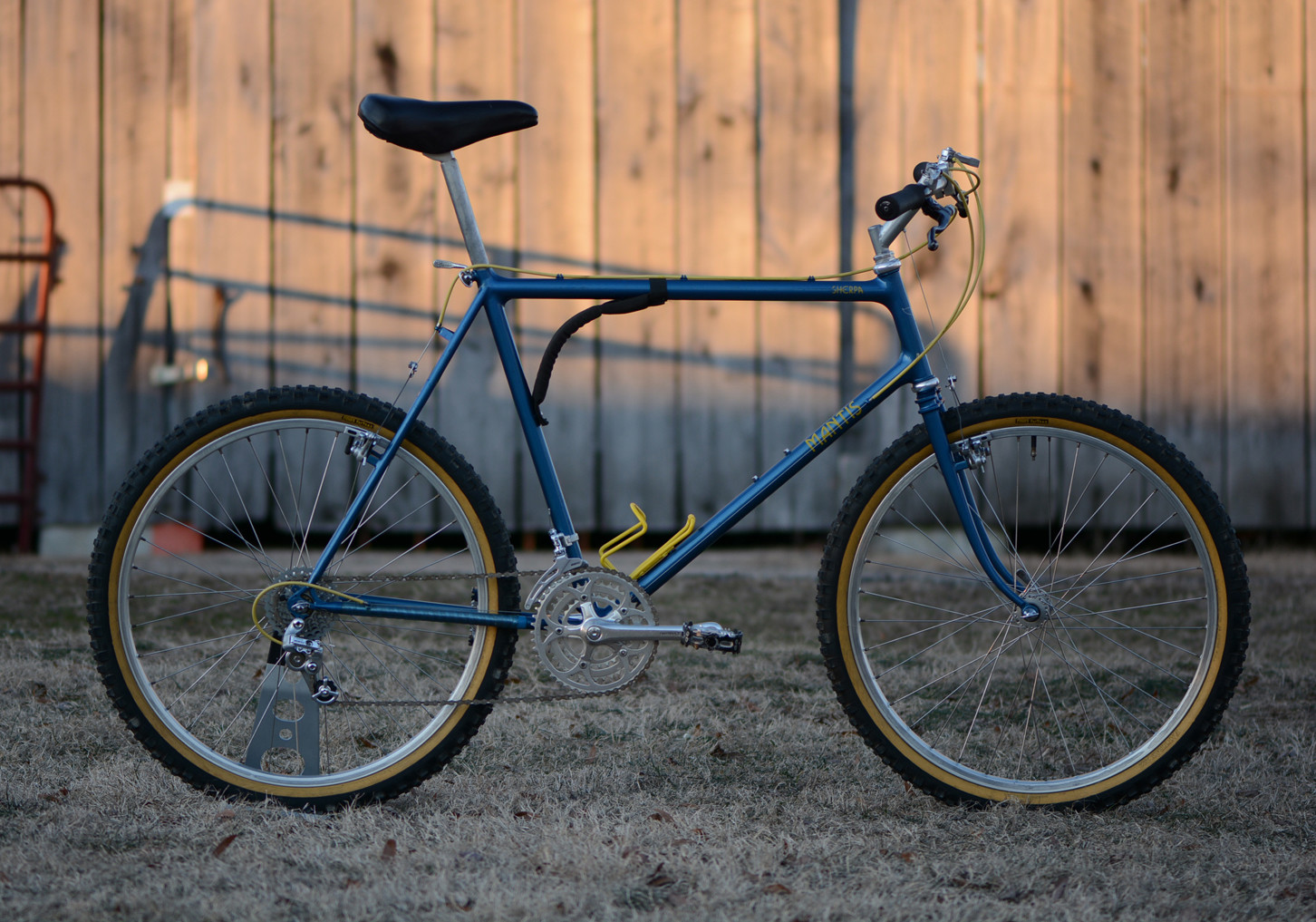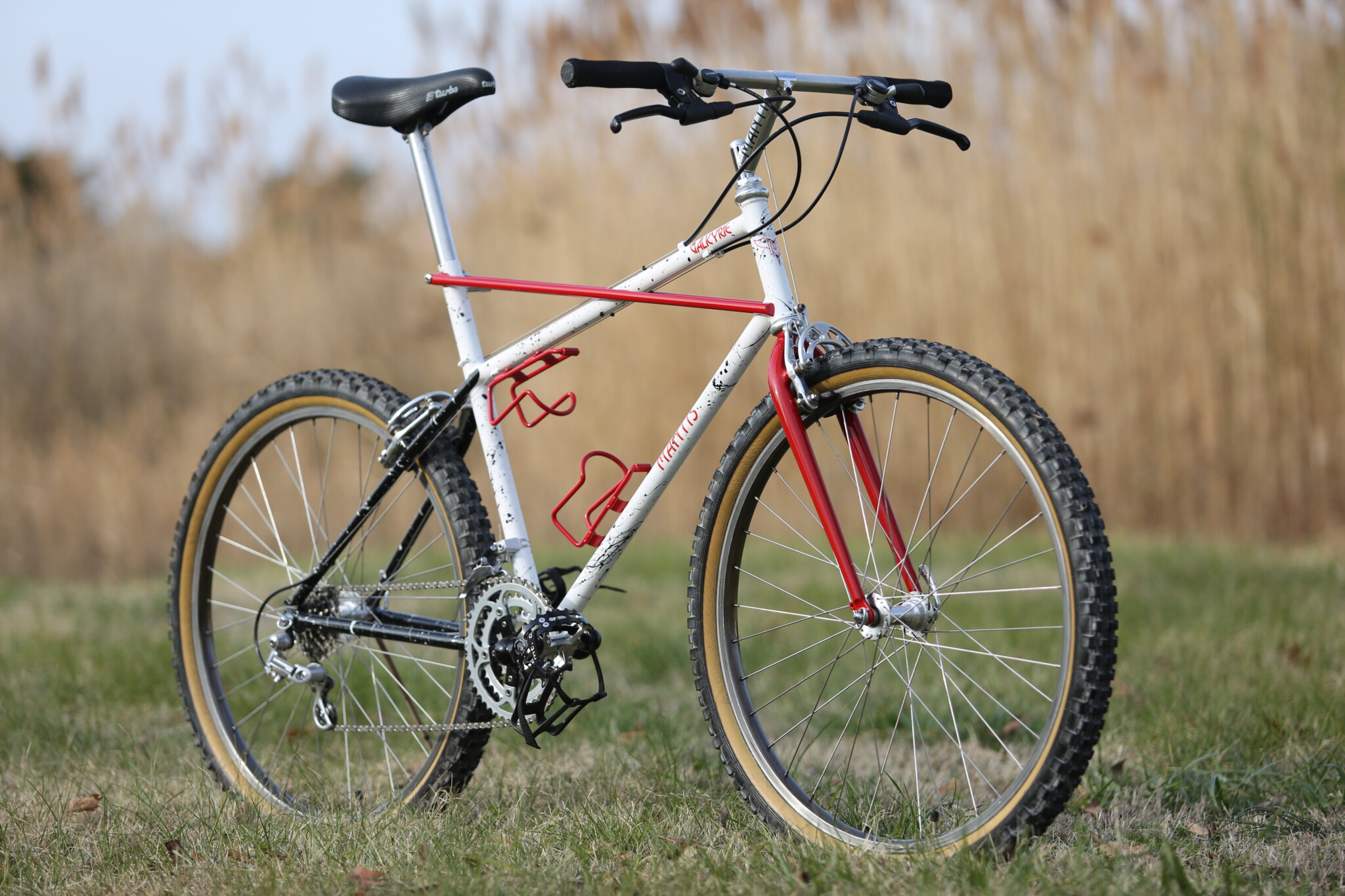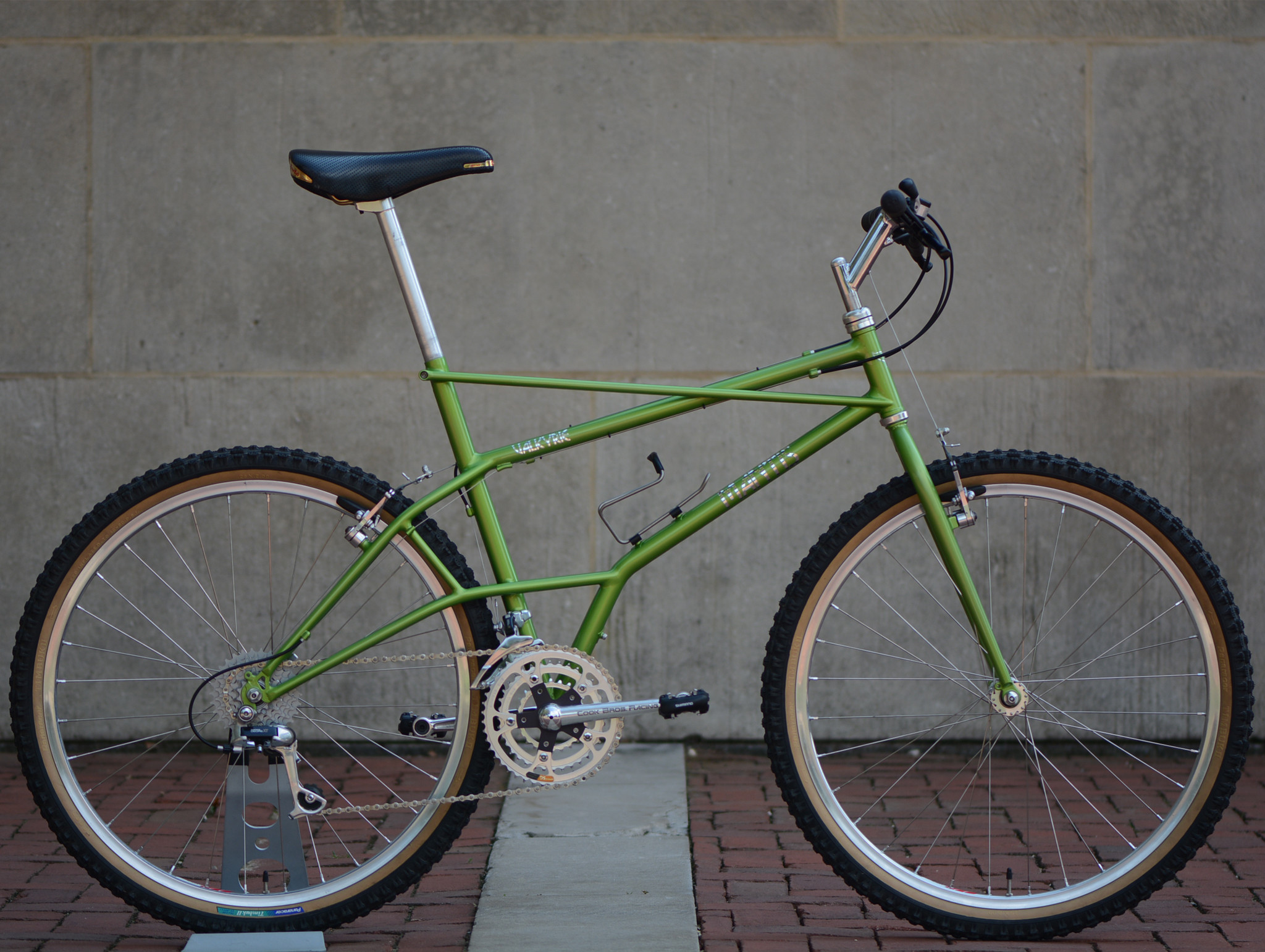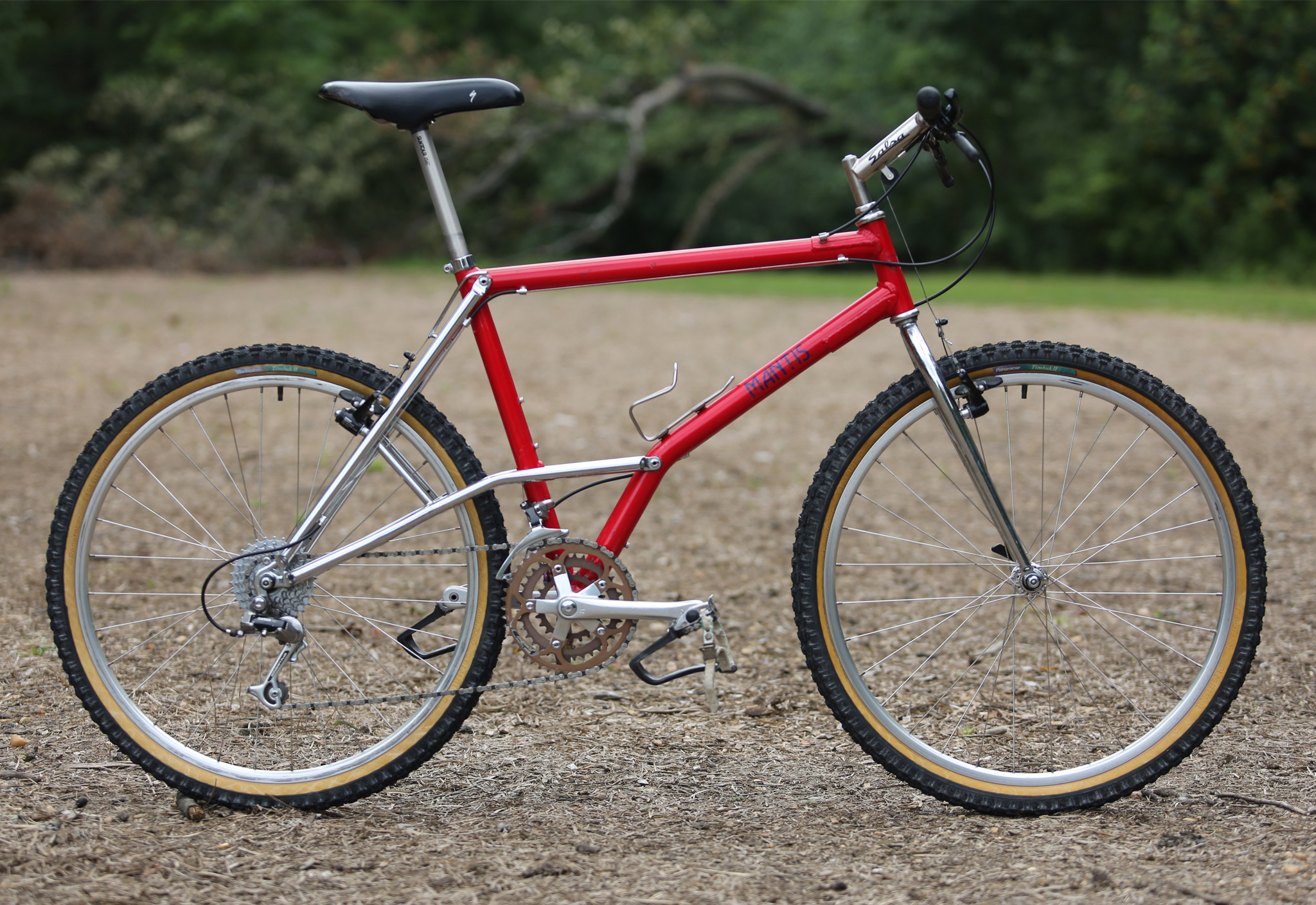A legend in its own time
I’ve been a Mantis since the early 90s when I first saw the Pro Floater grace the pages of Mountain Bike Action in 1992. It was a time when mountain bikes we transitioning from classic hardtails to new and exotic full suspension designs and Richard Cunningham was leading the pack with his new concept. The Pro-Floater was completely unattainable and as such it represented everything I wanted at the time. Technology moved rapidly and new designs entered rapidly and by the late 90s the mythical Pro-Floater became a bargain basement special and in 2000 I managed to buy not one, but two bright red Pro-Floaters from a gentleman who was no longer riding them. My father and I each ended up with one that we built up from scratch. I remember being absolutely floored by the bike, which by that time was nearly a decade old. I recall feeling it was almost telepathic anticipating every one of my thoughts and reacting accordingly. I loved it. Unfortunately I ended up selling it to pay for my last semester of college (my father still has his) and it would take another 15 years until I had a chance to ride one of Richard’s creations once again.

Formative years : 1981-1983
Richard Cunningham was a tinkerer at heart, whether it was ultra light planes, cars or motorcycles he was working on machines since his early childhood days. In his youth he gravitated towards anything with a motor, and it wasn’t until his 20s that he realized the impact those activities were having on the environment and started experimenting with mountain bikes. He initially took a job assembling Schwinn cruisers at a local bike shop, then a stint building road bikes at Medici. He got into road biking which eventually let to some gravel road explorations that got his wheels turning about the limitations of road bikes. All this led to RC building his first Mantis in 1981. Being new to mountain bikes he turned to friend and local mountain biker Monte Ward to put it through its paces. Early reports were not overly positive but RC wasn’t deterred. Along with early partner Mark Grayson they set out to improve and build upon their lessons. Early going wasn’t easy but they kept at it and in 1982 released their first catalog and lineup including the fillet brazed Sherpa and XCR and TIGd Overland.
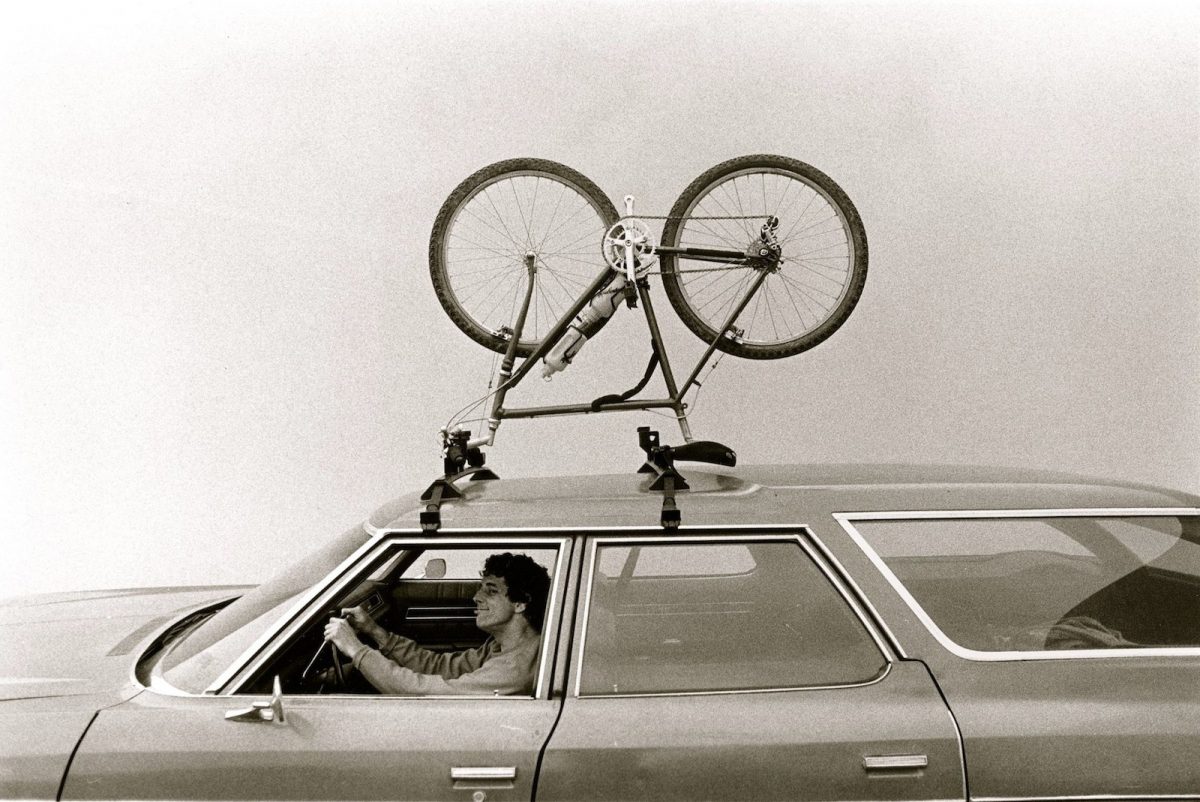
At first glance the Sherpa and XCR very nearly identical with both bikes featuring unique fillet brazing filled to a sharp ridge at both the head tube and seat tube junctions. The differences between the two are more than skin deep though. Both frames use 0.035″ thick 4130 chromoly tubing for the main triangle with the XCR using Columbus tubing for the rear triangle. The Sherpa also carries 18″ stays to the XCRs more aggressive 17.5″. All three bikes share dual 72 degree head and seat tube angles and the same biplane fork design with the Sherpa and XCR units getting more filing on visible welds. Each frame featured a gorgeously integrated Campagnolo seat-post quick release, very similar to what Ross Shafer did with his Salsa bikes. Beyond the frames all bikes got a custom made steel Mantis stem with a signature triangular Aluminum faceplate which served as the cable stop for the front brakes as well as a custom handlebar made from 6061T6 Aluminum. One last unique feature found primarily on the XCR was a customized Campagnolo track crankset drilled to received a granny gear resulting in a 2x setup geared heavily toward racing. RC made the modifications himself as an extra option and only a few ever left his shop with that custom crankset, while most bikes got a Specialized touring triple or a Sugino unit instead.
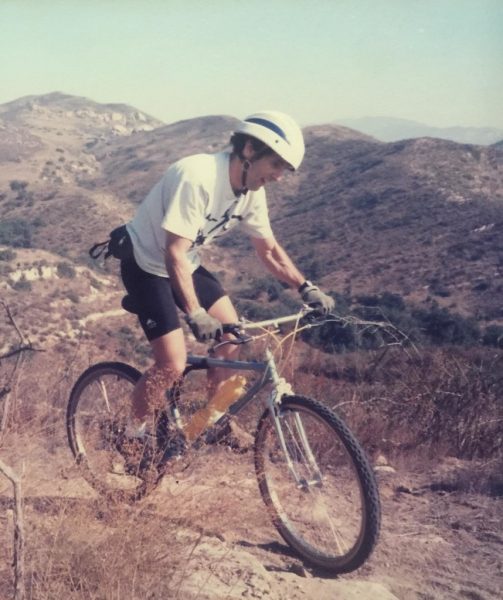
Photo courtesy of Christine Culver
While the Sherpa remained in production through 1985 and maybe as late as 1986 the Overland and fillet brazed XCR were only made in 1982 and 1983 and are some of the rarest Mantis bikes ever made. I maintain a small registry of the early Mantis bikes and have only seen two Overlands and five XCR. Based on the serial numbers of the XCRs it seems that at least nine were made, but obviously there could be more. Sherpas seems to be slightly more common with at least 23 getting made.
In my opinion these early Mantis bikes really don’t get the recognition they deserve. Majority of people these days seem to seek early steel bikes from Marin often overlooking what RC and others were doing down south and in other places. In the early days Mantis had a following among a close knit group of people and more often than not the bikes remained in Southern California perhaps contributing to the lack of knowledge and general awareness. However when compared to bikes like Ritchey, Potts or Salsa RCs early work stands shoulder to shoulder with their best work in terms of design aesthetic and ride quality.
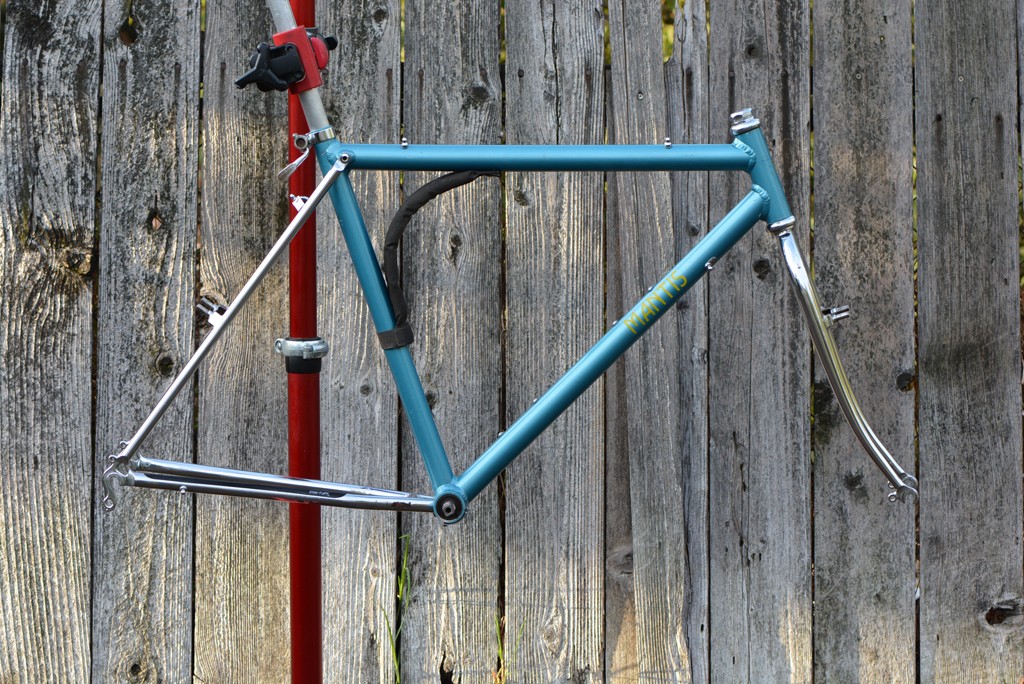
Innovation unleashed : Composite XCR
While RCs first bikes were unique they generally followed the same basic design tenets common throughout the fledgling mountain bike industry in 1984 he broke away from the pack and released the composite XCR. In this case composite referred not to carbon fiber but rather to the use of two different metals in the construction of the frame. The main triangle was constructed of 6061 Aluminun which was then mated to a chromoly rear end bolted via a bolted joint at the bottom bracket and below the seat cluster. The frame was mated to either a curved or later straight blade chromoly unicrown fork and included a Mantis stem, albeit now with a more traditional bar clamp. This resulted in a bike that was stiffer under pedaling loads while retaining some of the compliance characteristic of a steel bike. According to RCs these were not only lighter than comparable steel but also less expensive to fabricate. The Composite XCR quickly gained popularity and became one of the more prolific designs made by Mantis and under license to companies like Nishiki with their Alien model and Gary Fisher as the CR-7. The XCR remained in production into the early 90s with an elevated chainstay version joining the lineup around 1989/90. Although I have not ridden a non-elevated XCR I have a bit of seat time on the elevated version and found it a surprisingly fun bike to ride. The elevated version obviously has much shorter chainstays which when combined with the straight blade fork with 1.25″ of rake makes for a very agile and snappy handling bike that doesn’t ride as rough as a Klein while still retaining a solid pedaling platform.
The Composite XCR marked the beginning of a period of intense innovation coming out of RC and team at Mantis. While most companies released a slightly improved version of an existing design every couple years, starting in 1984 RC created a brand new bike design virtually every year.
With the shop turning out XCRs by the dozens RC turned his attention back to the design table and in late 1986 created what is to this day one of my favorite vintage bikes of all time, the X-Frame of Valkyrie.
Rewriting the Book : X/Valkyrie
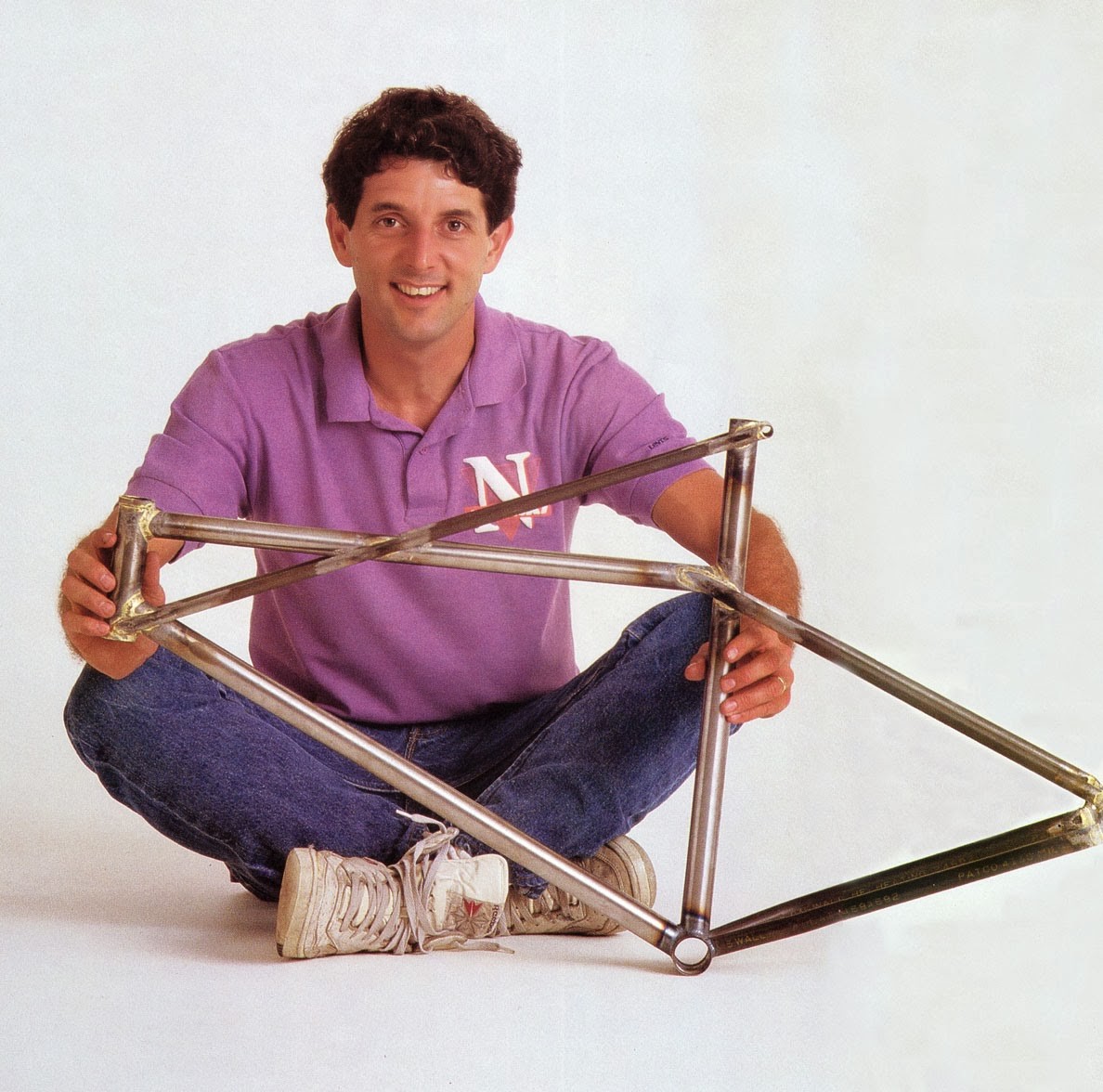
“The idea for the X frame came from an invitation from Gary Fisher to fly up to his bike company and do destruction testing on his new Super Caliber frames which featured the revolutionary Tange Prestige heat treated tubing. Gary was kind of angry because, as a contributor to MBA mag, I wrote that that particular frame buckled near the weld. The downtube must have not had a Tange DT, because when we pulled the fork towards the frame, the load cell ran up to about 700 pounds and then the frame tubes cracked open in three places as if they exploded. We then tested an oversized aluminum frame and it went up to 900 pounds before it buckled. (A standard chromoly frame buckles at 300 to 400 pounds.) Gary had an old Schwinn Excelsior cruiser frame laying around, so just for kicks, we put the big steel fork on the Schwinn and loaded it up – it went to over a thousand pounds and barely deflected when it failed. I went home thinking that, If a cantilever frame made from one-inch water pipe could out-perform a bunch of high-end mountain bikes, I should rethink the basic bike design.
So, the X-frame used smaller. lighter main tubes and x-braces. I configured the rear triangle to catch the X-tubes to make the stand-over height super low. The bikes worked well, in spite of the fact that the smaller main tubes made them laterally flexible. The Achilles heel was that V-brakes had not been invented yet and the cable routing had to go around the seat tube. Special care had to be taken to get the brakes to work correctly. The BB was TIG welded, because that was a big piece of metal and it made more sense, but I fillet brazed the rest of the frame myself, and at the time, I was really good at it, so I left the joints unfinished to lord this over the other builders of the time. (thought I’d tell it straight, just once.)
-RC”
The prototype for the X was featured in the August 87 issue of Mountain Bike Action. Much like he did in the early days RC relied on field testing of his machines under the skillful pilotage of friends and local racers. The prototype X-Frame was tested by Jim Harlow (aka Wiley Coyote) including racing it at the Norba Nationals, as well as by Mike Bell and Todd DeAngeles.
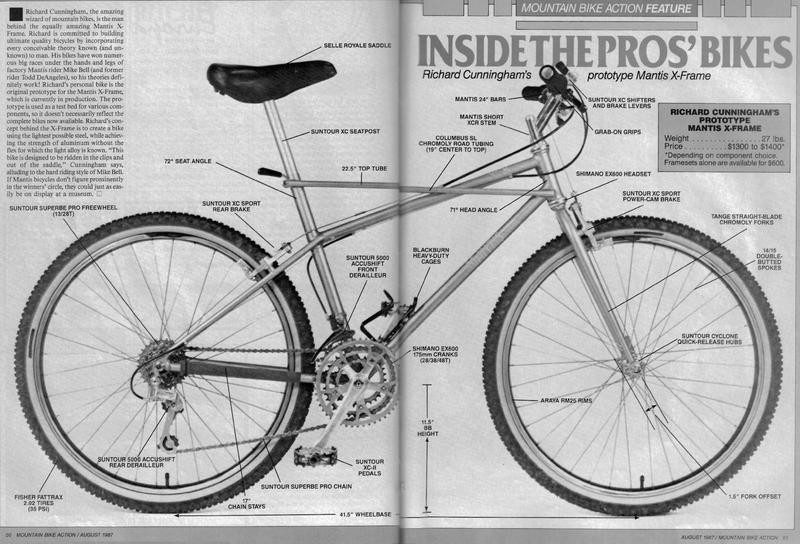
I have a couple dedicated pages to the X-Frame including two past and current personal Xs so please check those out for more details. Each X-Frame (and later Valkyrie) were made by RC personally, or so the story goes. The frames feature unfiled fillet brazing showcasing RCs skills with the torch. Only the BB shell is straight TIGd without any finishing touches to maintain strength at that critical interface. With 15-20 X-frames made in total virtually each bike is somehow different. However there are two main categories I lump these bikes into; ‘early’ and ‘late’. The early bikes are characterized by scalloped ends for the twin laterals where they meet the head tube, while the ‘later’ bikes have the laterals wrap around the headtube. Also most ‘early’ bikes have solid rear dropouts with ‘later’ bikes using dropouts with a triangular hole in the middle.
The lucky few who were able to get their hands on one of the X-Frames were rewarded with one of best riding bikes available. Often referred to as having a “magic carpet ride” combining both stiffness (which was the main buzz word for the 80s) with which you could attack climbs and compliance (a positive way to describe the lack of stiffness) preventing you from getting too beat up.
When most other bikes of the era sported a 43″ or longer wheelbase, the X with its 41.5″ wheelbase was a bit of an outlier and when combined with a 72 degree head tube and 74 seat tube angle made for a snappy bike which required a good deal of attention when the speeds crept up. I asked RC to provide some input in how he settled in on such a short wheelbase and here is what he came back with
“Much of that wheelbase can be attributed to shorter chainstays. At the time, the top tube lengths for each size was virtually dictated by old school bike shop owners who believed that a size medium had to have a 23 inch top tube, so the result was that most mountain bikes of the era had a half inch longer top tube than the equivalent road bike size and that was about as far as you could fudge it. The offset was a discovery we made trying a number of different offsets. We went as short as 1.25 inches because the increased trail gave the steeper head angles more stability, especially in deep sand. Two inch offsets were standard at the time because road touring bikes used that number. Bontrager was the only other guy who experimented with shorter offsets early on (Joe Breeze followed closely after), and because RockShox used Bontrager crowns to get started, Offsets suddenly were corrected worldwide.
-RC”
Getting high : Elevated Chainstays
Not to rest on his laurels RC kept pushing the envelope of design theory and in 1989 released the first pair of elevated chainstay mountain bikes with the Mantis Valkyrie and the elevated XCR. It’s worth noting that RC actually designed the elevated chainstay for Nishiki in 1988 with their Alien model, but that’s neither here nor there. The Valkyrie was a revised version of the X-Frame and carried the same basic front triangles of the X but converted the rear end into a cantilevered section effectively raising the chainstays up and away from the bottom bracket in an effort to provide more tire/mud clearance.
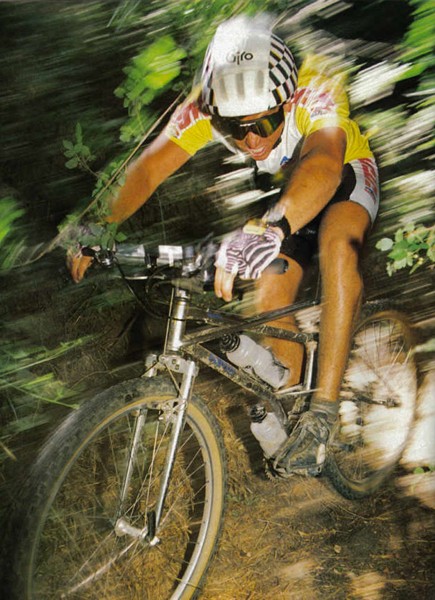
The Valkyrie was a bit more relaxed than X with 70.5 degree head tube and 72 degree seat tube angles, but had an ever shorter wheelbase measuring in at a mere 40″.
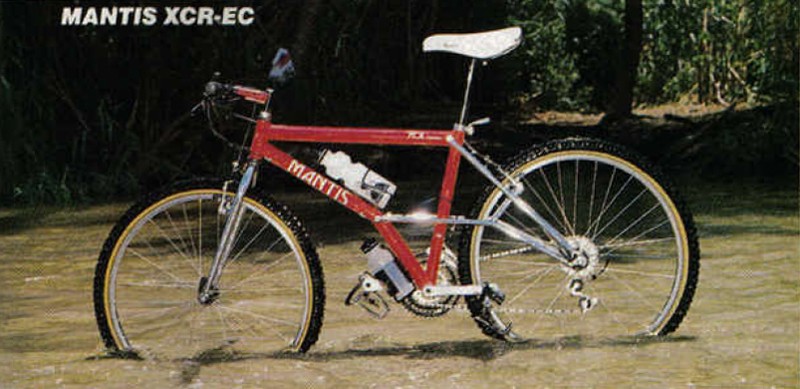
The elevated XCR, or XCR-EC took the basic principle developed on the Valkyrie and applied it to the venerable XCR design. The front triangle was revised with a bent downtube, to provide an additional anchor point for the rear end beyond the two at the top and middle of the seat tube. Unlike the elevated Valkyrie which was somewhat prone to failure the XCR was a more stout concept and most of the surviving examples are fully intact. The two bikes share virtually the same geometry with the XCR carrying a slightly longer wheelbase at 41″ even.
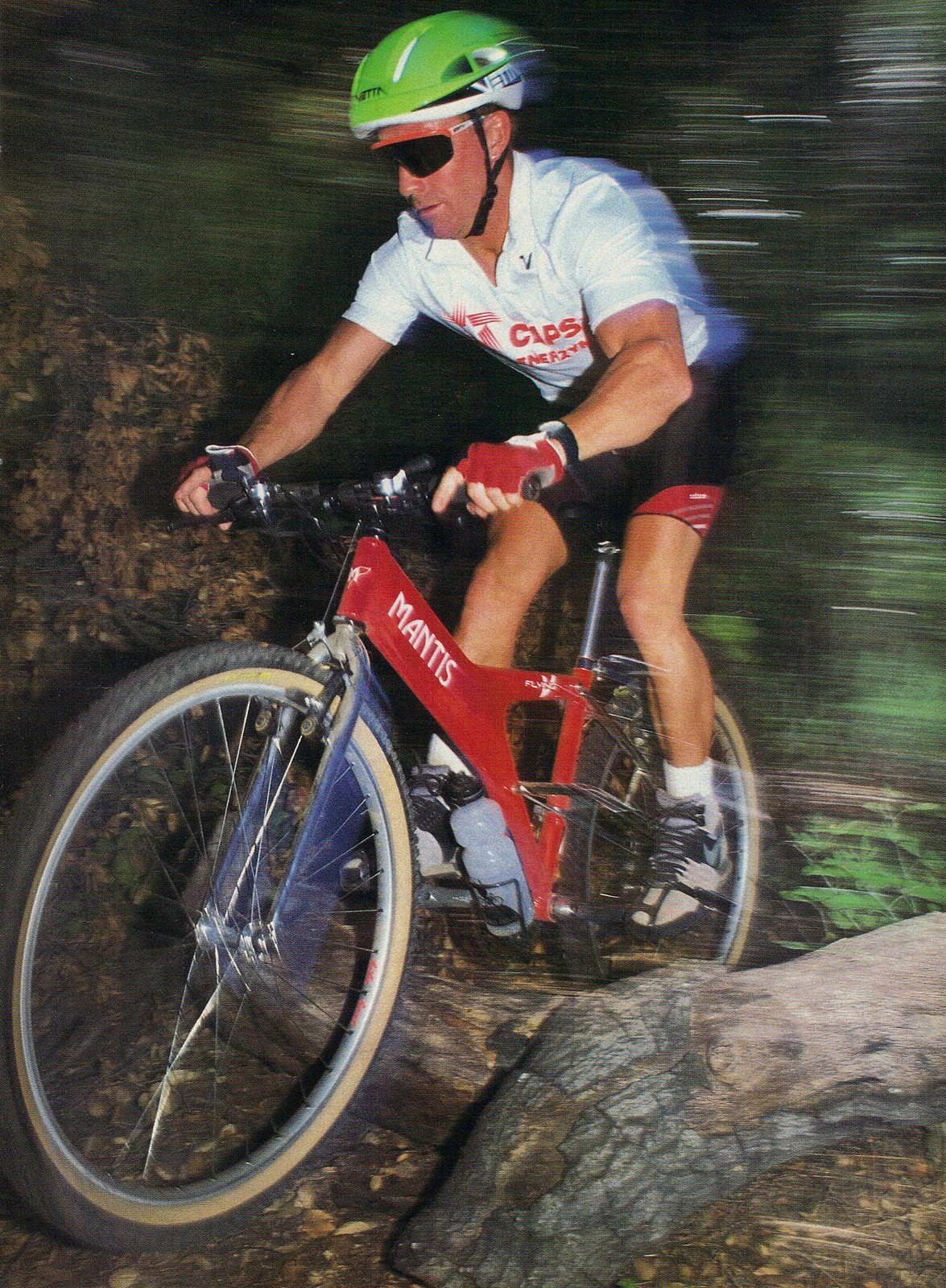
Continuing with the evolution of the elevated chainstays RC released the Flying-V in 1990. The Flying-V was essentially and XCR, but in lieu of the welded Aluminum tube main triangle it replaces it with a hand formed and welded Aluminum monocoque front section. One of the early adopters of Monocoque design in the mountain biking world RC relied on his experience building ultra-light airplanes and body panels for IMSA race cars to create a light-weight and stiff main section.
Both in name and shape the Flying-V is reminiscent of the famous Gibson guitar, right down to the rear brake and shifter cables running down the middle like guitar strings.
The bike received rave reviews in MBA and proved itself worthy on the NORBA circuit even logging a win at the Michigan round of the NORBA nationals piloted by Mantis team rider Pat Nolte (her bike now resides in the MBHof).
You’re Suspended : Mantis Pro-Floater
As I mentioned earlier the Pr0-Floater is the bike that drew me to Mantis in the first place, though my feelings on it now are somewhat bittersweet. The Pro-Floater heralded the end of Mantis as we know it, aside from some prototypes of an all Aluminum XCR the Pro-Flo would be RCs last design at Mantis and by the end wasn’t even made by RC or his in house team. Let’s not dwell on the negatives though, after all the Pro-Flo was hailed as one of the best FS bikes ever made when it was release. First shown as a prototype in late 1991 the Pro-Flo would be finally released to the public in 1992, that is if you could get one. I remember wanting one and though I couldn’t actually afford it that made little difference as wait times were over six months at the time.
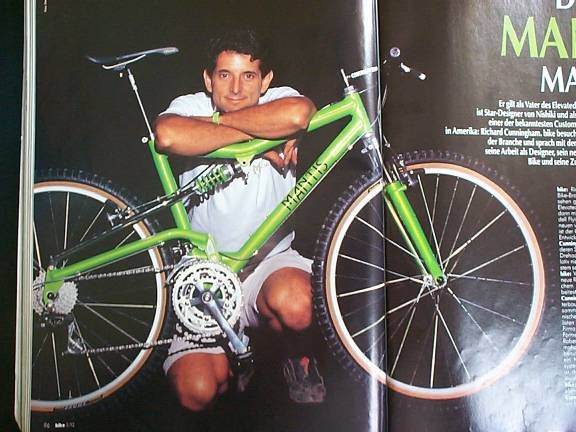
The Pro-Floater design leveraged heavily from the XCR utilizing a similar oversize 6061 main triangle with a bent top tube this time, allowing for the MacPherson strut rear end to be mounted in line with the top tube keping loads in line with the column. RC honed what he believed to be the ideal off road geometry for both high speed stability and neutral handing and employed that on the Pro-Floater which had a 70.5 degree head tube and a somewhat relaxed 73 degree seat tube angle. The reviews were nothing short of effusive with words like “revelation” and “mythical” sprinkled throughout the MBA article. The thing though, it was all true. Sure looking back at the bike through a 2020 lens it was flexy, it wondered and the travel was limited. But, back then it was a something else all together.
In closing
Although I first experienced Mantis in the waning years of the company, with time I delved deeper and deeper into the history of the company ultimately having the chance to work on and ride some of his earlier bikes including the fillet brazed XCR and Sherpa, the composite Aluminum and Steel XCR and the famous Valkyrie. While the Pro-Floater still holds a special place in my memory, my go to Mantis these days is an 1987 X-Frame or Valkyrie. It’s a bike I feel especially lucky to own and is one of my all time favorite vintage MTBs. I hope that through some of the restorations and reviews featured on this page you get a chance to learn and appreciate the early contributions that Richard Cunningham made to the world of mountain biking which is often overshadowed by his editorial work at MBA and Pinkbike.
1983 Mantis XCR
The Mantis XCR was Richard’s first race inspired bike. The fillet brazed version was only in “production” for two years before being replaced by the composite Aluminum-steel version in 1984. With fewer than ten fillet brazed XCRs likely made it’s one of the rarest Mantis bikes ever made.
1983 Mantis Sherpa
The Sherpa was the long distance touring bike of the early Mantis lineup. Along with the race oriented XCR and the somewhat budget minded Overland they comprised the line up of the first year of official production under the Mantis brand.
1987 Mantis X / Valkyrie
Though first on the page, this is my second (and current) X frame which replaced the blue bike below. The X, in my opinion is one of the more unique mountain bike designs, and maybe more important is that the design is not just an aesthetic choice by the builder but one that yields practical benefits on the trail. As a consequence a Mantis X has been in my collection for over ten years and will likely be one of the last bike to ever leave.
1988 X / Valkyrie
Although not the bike that introduced me to the brand the Valkyrie or X as it was initially called is the quintessential Mantis model. Its unique design, sublime construction and legendary ride combined with very limited production makes it one of the most desirable Mantis models in existence.
1990 Valkyrie
Richard is largely credited with introducing the elevated chainstay concept to the mountain bike world in 1989 with the Mantis Valkyrie. As if the regular Valkyrie wasn’t crazy enough the elevated version took things to a solid 11. Odds are if you ask a Mantis fan about their favorite bike this is the one they’re likely to cite.
1992 Mantis XCR
by the late 80s the composite XCR was the main model of the Mantis lineup along with the Valkyrie. It was only natural that after the introduction of the elevated chainstay version of the Valkyrie the XCR would get the same treatment. Characterized by their lively handling these are some of the favorite to ride among collectors.
Completed Projects:
Current Projects:
Newsletter sign up:
Subscribe to our newsletter to receive info on our latest projects and new podcast releases


